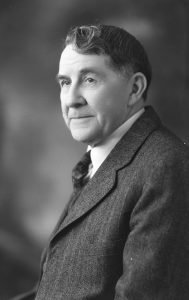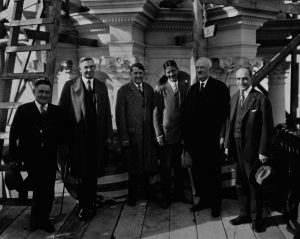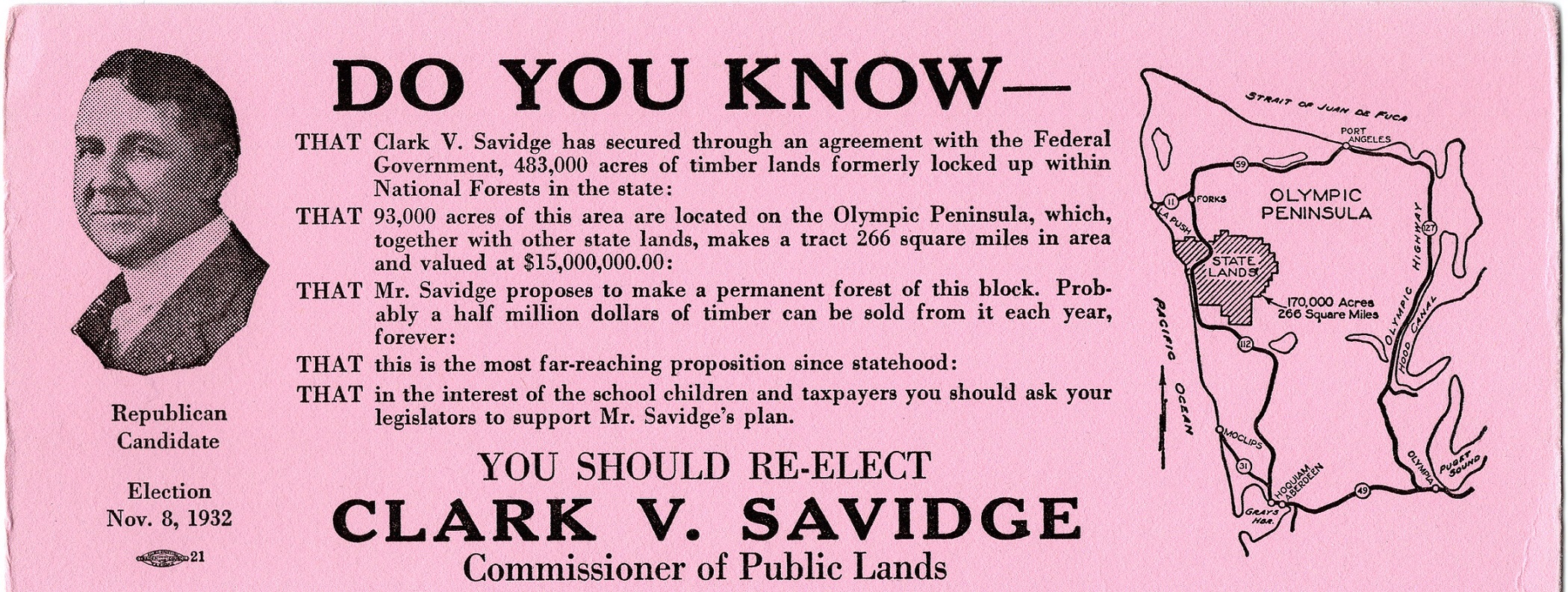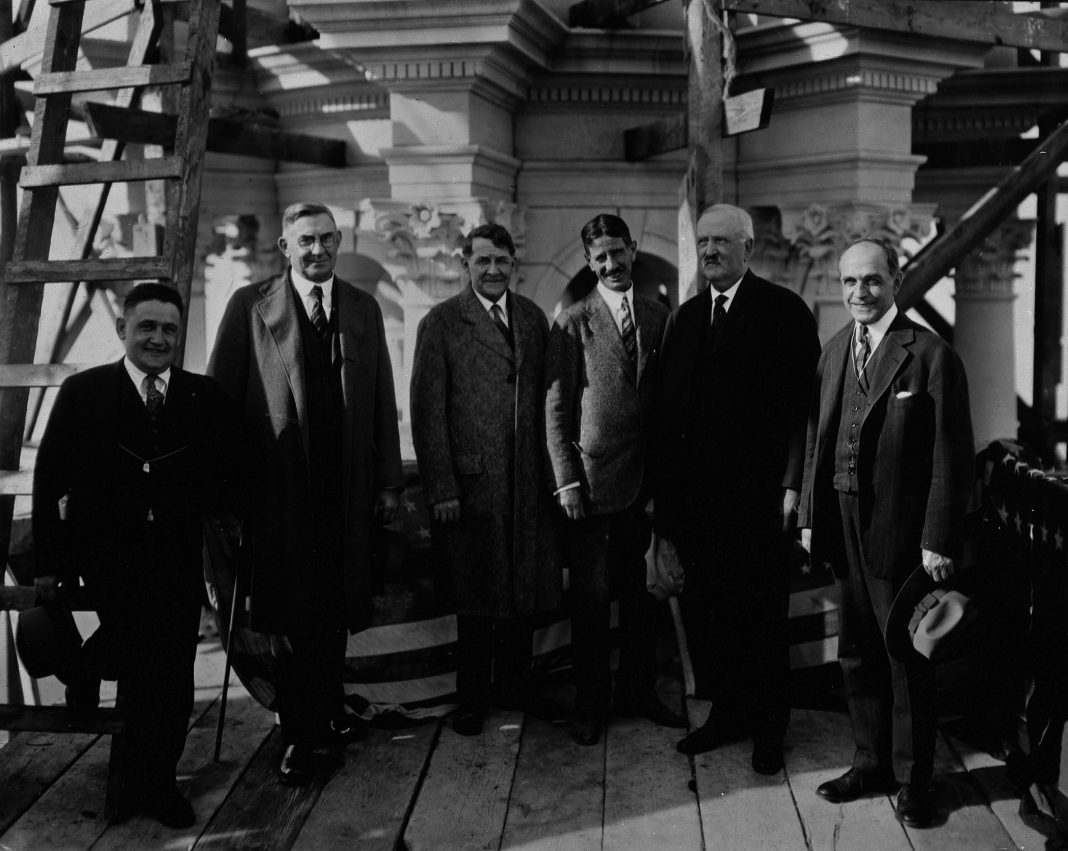October 13, 1926 was a long-awaited day. A large crowd gathered to watch the capstone being placed atop the Washington State’s capitol dome’s 47-foot-tall lantern. Celebrating the achievement, the capitol commission and guests gathered for a photo atop the dome during the event. Prominent in the photo was Public Lands Commissioner Clark Savidge, one of the biggest supporters of the project and an important state leader.
 Clark Voorhies Savidge was born on March 15, 1870 in Allentown, New Jersey to George (1842-1903) and Sarah (1846-1928) Savidge. George was a Civil War veteran. The family moved to a farm in Minnesota when Clark was 10 years old. In 1888, the family relocated again to Olympia where his father became chief of police. He kept the position until his sudden death in 1903.
Clark Voorhies Savidge was born on March 15, 1870 in Allentown, New Jersey to George (1842-1903) and Sarah (1846-1928) Savidge. George was a Civil War veteran. The family moved to a farm in Minnesota when Clark was 10 years old. In 1888, the family relocated again to Olympia where his father became chief of police. He kept the position until his sudden death in 1903.
Clark took a job with the Olympia post office in 1891, becoming one of the city’s first three mail carriers. Free delivery had just been established and numerous people applied for the job. Before that, people could only pick up their mail inside the post office.

As a mail carrier, Savidge delivered mail by horse, which was not without its misadventures. In 1891 he was recruited to herd stray cattle into the city pound. Another time, he suffered repeated thefts of the sack of oats he brought daily for his hardworking horse’s lunch. Described in a Morning Olympian article on June 24, 1895, the culprit “sack fiend” would slip into the shed near Seventh Street while Savidge was on his route. For the first few days, the culprit only took the sack, which had resell value, leaving the oats neatly in the feed box. Then, tired of being neat, he threw the oats everywhere before taking the sack.
Savidge ended up working for the post office for 19 years, serving also as a clerk and assistant postmaster. In 1910, he resigned from the post office to dedicate his time to the Knights of Pythias, a fraternal organization. He became Grand Instructor and traveled across the state.
In 1912, Savidge decided to run for Commissioner of Public Lands on the Republican ticket. He campaigned on the plank of extending civil service protections for workers in the department and public release of information about the department’s holdings and activities.
Savidge ended up winning the election. He ultimately served five terms, from 1913 to 1933. As commissioner of public lands, he oversaw state-owned lands and resources. Today the agency is known as the Department of Natural Resources (DNR).

One of Savidge’s earliest accomplishments was negotiating with the federal government for 500,000 acres of state lands held in forest reserves. He traded land with the federal government in order to consolidate scattered state land holdings into more consolidated blocks that would be more attractive to logging investments in the future. He also made timber cruises public and increased advertising of the timber sales beyond the county where the timber was located.
Because of his position, Savidge served as a member of various state boards, including the state capitol commission. It was this group that Savidge became most famous for and where he made his worst political enemy, Governor Roland Hartley. Hartley was in office from 1925 to 1933.
Although they were members of the same party, Hartley likely saw Savidge as a political rival as rumors constantly swirled around Savidge that he was thinking of running for the U.S. Senate. More troubling to Hartley perhaps was that state republicans had asked Savidge to run for governor in 1919. He refused.
The capitol commission was then made up of three members, Governor Hartley, Land Commissioner Savidge and State Auditor C. W. Clausen. The commission had great power over campus design, but Hartley constantly interfered and stirred up controversy over the project. Hartley accused Savidge and Clausen of corruption and campaigned against them. However, although Hartley would hold up a black bag of “evidence” at campaign stops, he never offered any proof that, in his words, would “jail the rotten bunch.”
Savidge defended his department before a special session of the state legislature in 1925 and still retained much support. He did not even have an opponent in the 1928 election. Savidge continued to receive much support from Thurston county. In 1920, after winning his third term, Savidge wrote to the Morning Olympian on November 7 to thank the county for giving him the most votes of any candidate as “such continued expressions of confidence from the home folks touches me deeply.”

While in office, Savidge proved a popular speaker. He was invited to talk across the state to civic and community groups. He spoke at the 1916 Olympia High School graduation ceremony. During World War I he traversed Thurston County promoting the Red Cross and YMCA.
Besides being a member of the Knights of Pythias for over 50 years, Savidge was active in other local organizations. He belonged to the Sons of the Veterans (a Civil War veteran descendant group) and spoke at many Memorial Day celebrations. He was a Mason and actively promoted YMCA membership campaigns. Savidge was also a singer, and sang at special events at his church, Temple Baptist of Olympia. In 1915 he even performed in the “Whirl of Mirth,” a program put on by the Knights of Pythias at the Olympia Theater.
But all things come to an end. Savidge lost re-election in 1933 when the Democrats swept into state offices in the excitement over FDR’s New Deal. He died on October 8, 1947 in Olympia at the age of 77. His wife Cynthia, whom he married in 1905, passed away in 1962. Savidge’s legacy is visible in the vast existing network of state lands and the current capitol building he worked so hard to have built.

















































